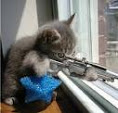There are two guiding principles in AAW:
The first is "defense in depth." This means that there are multiple rings of defenses around the task group.
The second is "shoot the archer, not the arrow." If what the ships in a task group are doing is shooting at incoming missiles, then the defenses have already suffered a partial failure. The defensive ring around the task group should be far enough out to enable engaging (and killing) the missile-launching platforms. During the Cold War, killing the missile shooters spanned almost every area of warfare at sea: ASW to stop the cruise-missile submarines, anti-surface warfare (ASUW) to sink the missile carrying craft, which ranged from small patrol boats to large cruisers and even aircraft carriers.
Weapons and tactics are nice to talk about, but the most important thing is command, control and communications (C3). Without C3, the long-range weapons were useless. C3 in AAW was done by two lines of communication: the Naval Tactical Data System (NTDS) and voice radio.
Let's begin with look at the most important player in the AAW game: Airborne early warning radar. In the 1950s, the Navy used one airframe for ASW, AEW and for cargo-hauling, which was built by Grumman Iron Works. This is an E-1 Tracer. Tracers served the Navy for 20 years, until replaced by the E-2 Tracker. The Navy was very happy to get the E-1 and even happier to get the E-2, for retirement of the E-1 (as well as its sisters, the S-2 and the C-1) meant that the Navy also retired the use of aviation gasoline.

This is an E-2.

Airborne early-warning radar has two big advantages. First off, the detection range of an airborne radar is much further than that of a ship's radar, because the horizion is lot further away. Second, because the AEW radar is not overhead of the task group, detection and location of an AEW radar signal only tells the enemy that there is a task group somewhere out there, but it does not reveal the location.
But the information from the radar operators aboard the AEW aircraft has to be communicated, and that'll be the subject of an upcoming post.

3 comments:
hmm, just a taste of what is to come...that isn't quite fair, is it?
Looks like you read Fleet Tacics; Theory and Practice, by Capt. Hughes...I thought it would be a good idea, as a history teacher and naval enthusiast, to be familiar with it.
I am looking forward to your next post with baited breath!!
Not only have I not read it, I've never heard of it. This is all from OJT.
Those are cool-looking planes. I look forward to the next installment!
Post a Comment